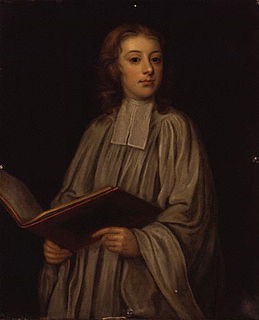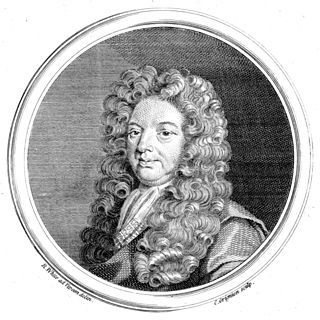The trio sonata is a genre, typically consisting of three or four movements with contrasting two melody instruments and a continuo. Originating in the early seventeenth-century, the trio sonata was a favorite chamber ensemble combination in the Baroque era.

John Playford (1623–1686/7) was a London bookseller, publisher, minor composer, and member of the Stationers' Company, who published books on music theory, instruction books for several instruments, and psalters with tunes for singing in churches. He is perhaps best known today for his publication of The English Dancing Master in 1651.

Dido and Aeneas is an opera in a prologue and three acts, written by the English Baroque composer Henry Purcell with a libretto by Nahum Tate. The dates of the composition and first performance of the opera are uncertain. It was composed no later than July 1688, and had been performed at Josias Priest's girls' school in London by the end of 1689. Some scholars argue for a date of composition as early as 1683. The story is based on Book IV of Virgil's Aeneid. It recounts the love of Dido, Queen of Carthage, for the Trojan hero Aeneas, and her despair when he abandons her. A monumental work in Baroque opera, Dido and Aeneas is remembered as one of Purcell's foremost theatrical works. It was also Purcell's only true opera, as well as his only all-sung dramatic work. One of the earliest known English operas, it owes much to John Blow's Venus and Adonis, both in structure and in overall effect. The influence of Cavalli's opera Didone is also apparent.

William Croft was an English composer and organist.
In religious music, the verse anthem is a type of choral music, or song, distinct from the motet or 'full' anthem.
Henry Cooke commonly known as Captain Cooke, was an English composer, choirmaster and singer. He was a boy chorister in the Chapel Royal and by the outbreak of the English Civil War was a Gentleman of the Chapel Royal. He joined the Royalist cause, in the service of which he rose to the rank of Captain. With the Restoration of Charles II he returned to the Chapel Royal as Master of the Children and was responsible for the rebuilding of the Chapel and the introduction of instrumental music into the services. The choristers in his charge included his successor and eventual son-in-law Pelham Humfrey, as well as Henry Purcell and John Blow.
Hail! Bright Cecilia (Z.328), also known as Ode to St. Cecilia, was composed by Henry Purcell to a text by the Irishman Nicholas Brady in 1692 in honour of the feast day of Saint Cecilia, patron saint of musicians.
Edward Purcell (1689–1740) was an English organist and composer.
Charles Dieupart was a French harpsichordist, violinist, and composer. Although he was known as Charles to his contemporaries, his real name may have been François. He was most probably born in Paris, but spent much of his life in London, where he settled sometime after 1702/1703. A prominent member of the Drury Lane musical establishment, Dieupart was active both as composer and performer and actively participated in the musical life of the city. However, after about 1712 he earned his income mostly by teaching, and in his later years lived in poverty. He is best remembered today for a collection of six harpsichord suites which influenced Johann Sebastian Bach's English Suites.
Fitzwilliam Sonatas is the name first given by Thurston Dart to an arrangement he made, based on two recorder sonatas by George Frideric Handel, which he recast as a group of three sonatas. The term was applied by later editors to the original two sonatas as Handel wrote them, and was also expanded to encompass several other sonatas for various instruments included in the Handel autograph manuscripts held by the Fitzwilliam Museum in Cambridge.

The Indian Queen is a largely unfinished semi-opera with music by Henry Purcell, first performed at the Theatre Royal, Drury Lane, London, in 1695. The exact date is unknown, but Peter Holman surmises it may have been in June.
William Turner was a composer and countertenor of the Baroque era. A contemporary of John Blow and Henry Purcell, he is best remembered for his verse anthems, of which over forty survive. As a singer, he was a Gentleman of the Chapel Royal from 1669 until his death.

Baroque music of the British Isles bridged the gap between the early music of the Medieval and Renaissance periods and the development of fully fledged and formalised orchestral classical music in the second half of the eighteenth century. It was characterised by more elaborate musical ornamentation, changes in musical notation, new instrumental playing techniques and the rise of new genres such as opera. Although the term Baroque is conventionally used for European music from about 1600, its full effects were not felt in Britain until after 1660, delayed by native trends and developments in music, religious and cultural differences from many European countries and the disruption to court music caused by the Wars of the Three Kingdoms and Interregnum. Under the restored Stuart monarchy the court became once again a centre of musical patronage, but royal interest in music tended to be less significant as the seventeenth century progressed, to be revived again under the House of Hanover. The Baroque era in British music can be seen as one of an interaction of national and international trends, sometimes absorbing continental fashions and practices and sometimes attempting, as in the creation of ballad opera, to produce an indigenous tradition. However, arguably the most significant British composer of the era, George Frideric Handel, was a naturalised German, who helped integrate British and continental music and define the future of the classical music of the United Kingdom that would be officially formed in 1801.
Henry Bowman, was an English composer musician, based in Oxford, of whose life little is recorded.

Remember not, Lord, our offences, Z.50, is a five-part choral anthem by the English baroque composer Henry Purcell (1659–95). The anthem is a setting of a passage from the litany compiled by Thomas Cranmer, Archbishop of Canterbury, and later included in the Anglican Book of Common Prayer. It was composed circa 1679–82 at the beginning of Purcell's tenure as Organist and Master of the Choristers for Westminster Abbey.

Hear my prayer, O Lord, Z. 15, is an eight-part choral anthem by the English composer Henry Purcell (1659–1695). The anthem is a setting of the first verse of Psalm 102 in the version of the Book of Common Prayer. Purcell composed it c. 1682 at the beginning of his tenure as Organist and Master of the Choristers for Westminster Abbey.
Welcome to all the pleasures, Z. 339, is a 1683 composition by Henry Purcell, the first of a series he wrote in honour of the patron saint of music, Saint Cecilia. It was commissioned by an organisation called "The Musical Society" for performance in November 1683.





